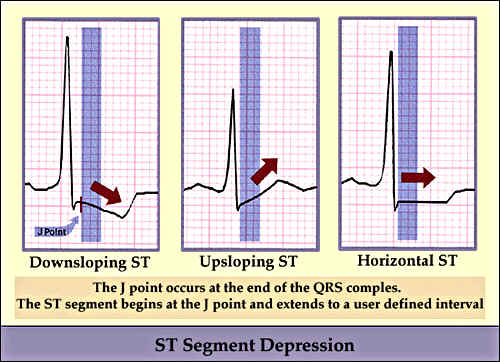Chronic stable angina electrocardiography
|
Chronic stable angina Microchapters | ||
|
Classification | ||
|---|---|---|
| ||
| ||
|
Differentiating Chronic Stable Angina from Acute Coronary Syndromes | ||
|
Diagnosis | ||
|
Alternative Therapies for Refractory Angina | ||
|
Discharge Care | ||
|
Guidelines for Asymptomatic Patients | ||
|
Case Studies | ||
|
Chronic stable angina electrocardiography On the Web | ||
|
to Hospitals Treating Chronic stable angina electrocardiography | ||
|
Risk calculators and risk factors for Chronic stable angina electrocardiography | ||
Editors-In-Chief: C. Michael Gibson, M.S., M.D. [1] Phone:617-632-7753; Cafer Zorkun, M.D., Ph.D. [2]; Associate Editor-in-Chief: Smita Kohli, M.D.
Electrocardiography (ECG) at Rest
The ECG is critical not only to add support to the clinical suspicion of CAD but also to provide prognostic information based on the pattern and magnitude of the abnormalities.
It is in normal range in approximately half of patients with chronic stable angina without a history of previous myocardial infarction. In the others, a variety of ECG finding may suggest an ischemic heart disease.
Q waves may suggest prior myocardial infarction, but in the absence of a clinical history of previous myocardial infarction or CAD, Q waves may also be caused by other conditions, including hypertrophic cardiomyopathy, left ventricular hypertrophy, dilated non ischemic cardiomyopathy and accessory conduction pathways. Isolated Q waves in lead III or QS pattern in V1 and V2 are nonspecific for diagnosis.
The occurrence of ST segment depression and T wave inversion in the resting ECG, and signs of left ventricular hypertrophy, left bundle branch block (LBBB) and left anterior hemiblock LAH are compatible with, favors to, but are not specific for CAD. A physician should consider these abnormal ECG findings as indications for further evaluation. Giant T-wave inversion in precordial leads is sometimes an important indicator of severe Left Anterior Descending (LAD) artery stenosis.
ST segment changes in angina can be seen as downsloping, upsloping or horizontal ST depressions.
ACC / AHA Guidelines- ECG / Chest X-Ray (DO NOT EDIT)[1]
| “ |
Class I1. Rest ECG in patients without an obvious noncardiac cause of chest pain. (Level of Evidence: B) 2. Rest ECG during an episode of chest pain. (Level of Evidence: B) |
” |
See Also
Sources
- TheACC/AHA 2002 Guideline Update for the Management of Patients With Chronic Stable Angina [2]
- The ACC/AHA/ACP–ASIM Guidelines for the Management of Patients With Chronic Stable Angina [1]
- The 2007 Chronic Angina Focused Update of the ACC/AHA 2002 Guidelines for the Management of Patients With Chronic Stable Angina [3]
References
- ↑ 1.0 1.1 Gibbons RJ, Chatterjee K, Daley J, et al. ACC/AHA/ACP–ASIM guidelines for the management of patients with chronic stable angina: executive summary and recommendations: a report of the American College of Cardiology/American Heart Association Task Force on Practice Guidelines (Committee on Management of Patients With Chronic Stable Angina). Circulation. 1999; 99: 2829–2848. PMID 10351980
- ↑ Gibbons RJ, Abrams J, Chatterjee K, Daley J, Deedwania PC, Douglas JS, Ferguson TB Jr, Fihn SD, Fraker TD Jr, Gardin JM, O'Rourke RA, Pasternak RC, Williams SV, Gibbons RJ, Alpert JS, Antman EM, Hiratzka LF, Fuster V, Faxon DP, Gregoratos G, Jacobs AK, Smith SC Jr; American College of Cardiology; American Heart Association Task Force on Practice Guidelines. Committee on the Management of Patients With Chronic Stable Angina. ACC/AHA 2002 guideline update for the management of patients with chronic stable angina--summary article: a report of the American College of Cardiology/American Heart Association Task Force on Practice Guidelines (Committee on the Management of Patients With Chronic Stable Angina). Circulation. 2003 Jan 7; 107 (1): 149-58. PMID 12515758
- ↑ Fraker TD Jr, Fihn SD, Gibbons RJ, Abrams J, Chatterjee K, Daley J, Deedwania PC, Douglas JS, Ferguson TB Jr, Gardin JM, O'Rourke RA, Williams SV, Smith SC Jr, Jacobs AK, Adams CD, Anderson JL, Buller CE, Creager MA, Ettinger SM, Halperin JL, Hunt SA, Krumholz HM, Kushner FG, Lytle BW, Nishimura R, Page RL, Riegel B, Tarkington LG, Yancy CW; American College of Cardiology; American Heart Association; American College of Cardiology/American Heart Association Task Force on Practice Guidelines Writing Group. 2007 chronic angina focused update of the ACC/AHA 2002 Guidelines for the management of patients with chronic stable angina: a report of the American College of Cardiology/American Heart Association Task Force on Practice Guidelines Writing Group to develop the focused update of the 2002 Guidelines for the management of patients with chronic stable angina. Circulation. 2007 Dec 4; 116 (23): 2762-72. Epub 2007 Nov 12. PMID 17998462
